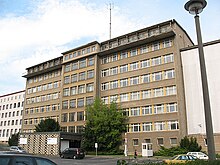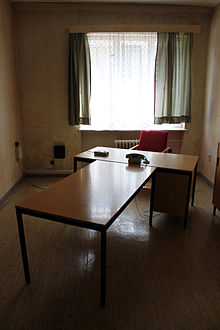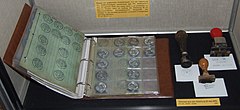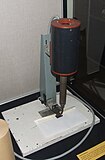用戶:Ericmetro/沙盒6
| 國家安全部 | |
| Ministerium für Staatssicherheit | |
 | |
| 機構概要 | |
| 成立時間 | 1950年2月8日 |
| 解散時間 | 1990年10月4日(兩德統一) |
| 機構駐地 | 東德東柏林魯斯徹斯特街103號 |
| 格言 | "Schild und Schwert der Partei" 「黨的劍與盾」 |
| 僱員數目 | 90,000(1989年)[1] |

國家安全部(德語:Ministerium für Staatssicherheit,MfS),簡稱「史塔西」(Stasi,國際音標:[ˈʃtɑːziː],Staatssicherheit),是德意志民主共和國(東德)的國家安全及情報機構。史塔西被認作當時世界上最有效率的情報和秘密警察機構之一。[2][3][4][5][6][7]史塔西成立於1950年2月8日,蘇聯的克格勃對其產生了很大影響。其總部位於東柏林,在柏林-梅克倫堡建有一座大樓,東柏林其他地方亦分佈着一些史塔西的機構。若干史塔西官員在1990年後因其罪行被起訴。
史塔西的格言是「黨的劍與盾」(Schild und Schwert der Partei),其中黨所指為東德執政的德國統一社會黨,這一格言描述了其在東德政治中的作用。史塔西主要負責壓制國內的政治異議者以及擔任統一社會黨對東德國民的監視工具,這有助於統一社會黨權力的鞏固。對反對派、活躍分子及不同政見者也會採用恐嚇的方式加以威脅。[8][9]史塔西也負責東德的國際情報收集,國家人民軍中也有史塔西的單位。
歷史
[編輯]前身
[編輯]成立和發展
[編輯]德意志民主共和國國家安全部成立於1950年2月8日,蘇聯的兩個類似部門——內務人民委員部和國家安全部(克格勃)對其產生了很大影響。1946年8月,統一社會黨建立了德國內務部(Deutschen Verwaltung des Inneren,DVdI),最初目的為保護蘇占區的經濟穩定。1948年,該部門和政治警察被整合至「K5」,職員增加至700人。「K5」部門作為政治警察承擔了佔領區的去納粹化任務,負責逮捕前納粹官員並進行簡單快速的審判。[10]
國家安全部的首任部長為威廉·蔡瑟,其副手為埃里希·梅爾克。[11]1953年六一七事件後,威廉·蔡瑟曾試圖使統一社會黨總書記瓦爾特·烏布利希下台,但沒有成功。[12]隨後烏布利希任命了恩斯特·沃爾韋伯為國家安全部部長。1957年恩斯特·沃爾韋伯與烏布利希和埃里希·昂納克發生了衝突隨後辭職,其副手埃里希·梅爾克最終成為了國家安全部部長。
1957年馬庫斯·沃爾夫成為了史塔西的外國情報機構——情報管理總局(Hauptverwaltung Aufklärung,HVA)局長,他成功地使東德間諜打入西德政治商業圈,期間發生的君特·紀堯姆間諜事件導致了西德總理維利·勃蘭特於1974年5月下台。
六一七事件
[編輯]柏林圍牆修建之後
[編輯]國家安全辦公室
[編輯]解體
[編輯]
東德停止存在的前幾年,史塔西的探員招募變得越發困難,1986年之後新探員的新加入率變為負值。史塔西對民眾的監察工作因而受到了很大影響,在這期間社會變得愈發不穩定,史塔西的行動也變得廣為人知。[13] 史塔西在這一時期的任務是在經濟惡化的前提下解決政治問題,壓制國家面對的嚴峻形勢。然而,史塔西並未成功。[14]
1989年11月7日,面對東德政治和社會的劇變,埃里希·梅爾克決定辭職。1989年11月17日,東德部長委員會將史塔西更名為「國家安全辦公室」(Amt für Nationale Sicherheit – AfNS),由沃爾夫岡·施萬尼茨中將擔任領導者。1989年12月8日,東德總理漢斯·莫德羅決定解散國家安全辦公室,東德部長委員會在12月14日批准了這一決定。
這一決定將國家安全辦公室拆分為兩個不同的機構:「民主德國情報局」(Nachrichtendienst der DDR),負責境外情報搜集。「民主德國憲法維護辦公室」(Verfassungsschutz der DDR),與西德的德國聯邦憲法維護廳相對應。但公眾對此仍有極為激烈的反應,在圓桌會議(Runder Tisch)的壓力下,東德政府撤銷了設立民主德國憲法維護辦公室的計劃,直接在1990年1月13日解散了國家安全辦公室。其部分權責被交給民主德國內務部,它也負責管理國家安全辦公室留下的設施。
柏林圍牆倒塌後,德國國會調查了消失的東德公用資金。最終發現大量資金流向了奧地利商人、史塔西非正式僱員 Martin Schlaff 設在列支敦士登的賬戶。他曾負責與東德進行貿易往來。許多史塔西高級官員也在他旗下的公司謀得了職位。例如史塔西在德累斯頓的長官 Herbert Kohler 在1990年將17,000萬馬克以購買硬盤的名義轉至他的賬戶,幾個月之後再到他的公司工作。[15][16]
衝擊史塔西總部
[編輯]東德政府行將倒台之際,史塔西亦不能倖免。史塔西職員隨即使用碎紙機和人手銷毀其存留的大量檔案。但人們隨後發現了史塔西的動作,1990年1月15日傍晚,一大群人聚集在總部門口試圖阻止檔案的銷毀工作。[17]當時人群中意識到這些檔案應該讓人們查閱,且要被用來審判史塔西的行徑。人們聚集得越來越多,直到衝破了警察的封鎖進入了大樓。示威者們砸壞了大樓中的門窗、踩踏東德領導人埃里希·昂納克的畫像。在這些示威者中也有西德政府的工作人員以及尋求暗自破壞檔案的史塔西線人。史塔西最終共銷毀了約5%的檔案[18],一說紙質文檔多達十億張。[1]
工作
[編輯]| 人數 | 系統 |
|---|---|
| 每166名公民[19] | 東德史塔西 |
| 每273名公民[20] | 俄羅斯聯邦安全局 |
| 每428[20]-583[19]名公民 | 蘇聯克格勃 |
| 每900名公民[21] | 捷克斯洛伐克國家安全部 |
| 每1,500名公民[22] | 美國國土安全部 |
| 每2,000名公民[19] | 納粹德國蓋世太保 |
境內
[編輯]滲透
[編輯]東德國內的大型工廠多被史塔西安排全職探員進駐,其滲透規模依據工廠的經濟價值決定。[14]通常每棟公寓樓中亦有一個房客擔任史塔西的通報者,並向所在地區的人民警察匯報,一旦發現住戶的親屬或朋友留在公寓過夜,通報者就會向上級報告。[19]史塔西也曾在賓館和公寓房間牆壁上鑽孔放置攝像機監視公民活動。[19]中小學、大學及醫院通常被史塔西探員高度滲透。
史塔西建立了通報者的正式歸類方法,同時制定了從這些通報者中獲取信息並加以控制的規程。[23]一些通報者來自國家安全機構(如警察或軍隊),另一些則來自不同政見者活動的領域(如藝術界和新教教會)。[24]史塔西通常會使通報者感受到自己的重要性,同時給予他們物質或社會地位上的獎勵,並讓他們有冒險的感覺。根據官方統計,僅7.7%的通報者是被迫參與的。通報者的另一個重要來源是統一社會黨黨員。卡車司機、看門人、醫生、護士和教師也是通報者的主要來源,米爾克認為有頻繁接觸公眾機會的人最適合成為通報者。[25]
1975年東歐國家簽署《赫爾辛基協議》後,史塔西的地位大幅提高。埃里希·昂納克認為《赫爾辛基協議》規定簽署國須尊重「包括思想自由、良心自由、宗教自由以及觀點自由在內的基本人權」是對其政權的一個嚴重威脅。[26]自1950年代初,史塔西的通報合作者數量從2萬到3萬逐步上升到1968年的10萬人以應對西德提出的東方政策以及六八運動,並在1975年達到18萬人的最高峰。[27]史塔西還在如波蘭等仇視蘇聯人的東方陣營國家擔任克格勃的代理機構。[28]
東德居民生活中的各個方面都被史塔西滲透。1980年代中期,東西德的史塔西通報合作者均開始增長。1989年東德政府倒台時,史塔西僱傭了91,015名正式職員以及173,081名非正式合作者。[29]幾乎每63名東德居民間就有一名與史塔西合作,[30]而每166名東德居民就有一名史塔西的正式僱員。如果將通報者考慮在內,每6.5人就有一名史塔西通報者。與之相比納粹時期每2000人才有一名蓋世太保正式僱員。 [31]另外史塔西也滲透到了西德的政府和情報機構。
有些情況下,夫妻之間甚至也會彼此監視。例如,和平活動家菲拉·綾絲菲爾德(Vera Lengsfeld)的丈夫克努得·沃倫伯格(Knud Wollenberger)即是史塔西的通報合作者。[25]
心理騷擾
[編輯]
史塔西建立了對嫌疑人進行心理騷擾的方式——「侵蝕」(德語:Zersetzung),這一名稱來自化學詞彙,意為腐蝕、分解。
1970年代始,逮捕及酷刑折磨等公開迫害的方式被史塔西認為過於殘酷和明顯。由於心理騷擾不易留下痕跡,且難以推測其性質和來源,故很難激發受害者和及其支持者的反抗行為。「侵蝕」方法的應用目標通常是恐嚇嫌疑人以擊垮其意志,從而使其停止其「不當行為」。
「侵蝕」方法的手法通常是騷擾受害者的私人生活以使其產生不安感,例如進入其房間搬動家具的位置、重設鬧鐘的鬧響時間、撤下牆上的畫或是調換茶壺中的茶葉。亦有通過安裝竊聽器、抹黑其名譽、誣告、神秘電話、匿名包裹等其他心理攻勢,甚至包括向受害者的妻子寄送性玩具來實施騷擾。受害者通常不會想到背後的策劃者是史塔西。許多人因此陷於精神錯亂、崩潰甚至自殺。
利用「侵蝕」方法騷擾犯人的好處是不會留下明確的證據,這對東德在1970至1980年代提升自身國際地位而言有很重要的意義。現今俄羅斯聯邦安全局等情報機關仍有使用這一方法。[32]
境外
[編輯]Other files (the Rosenholz Files), which contained the names of East German spies abroad, led American spy agencies to capture them. After German reunification, it was revealed that the Stasi had secretly aided left-wing terrorists such as the 紅軍派, even though no part of the RAF had ever been ideologically aligned with the GDR.
Directorate X was responsible for disinformation. Rolf Wagenbreth, director of disinformation operations, stated "Our friends in Moscow call it 『dezinformatsiya'. Our enemies in America call it 『active measures,』 and I, dear friends, call it 『my favorite pastime'".[33]
暗殺活動
[編輯]法律依據
[編輯]架構
[編輯]
史塔西中央和地方機構內部以職責和技術性質劃分部門結構(例如第二部門:反間諜;第九部門:調查;第二十部分:國家機關、人民團體、教會、文化部門和地下活動)。部門通常以羅馬數字命名。地區一級有設在柏林史塔西總部的工作組,縣一級則不完全應用此規則。[34]
組織結構
[編輯]- 國家安全部
- 第26部(Abteilung 26)–負責針對嫌疑人的竊聽。
- 武器和化學用品部(BCD)
- 經濟部
- 通信部 - 保障各部門間通訊順暢。
- 第十部 – 協調國際關係。
- 第十一部 – 民主德國中央加密局(ZCO)。
- 第十四部 – 中央監獄管理局,負責柏林-霍恩舍恩豪森和史塔西總部的兩個拘役營的看守工作,並監管下屬15個史塔西轄區內的拘役營。
- 第二十三部 – 反恐和特別行動部,1989年與第二十二中央部合併,管轄國家安全部行動部隊,具有作戰、保衛、航空監控、空降和潛水小隊。[35]
- 商務協調工作組(AG BKK)– 服務於亞歷山大·沙爾克-格洛科斯基的商務協調機關[36]。
- 部長工作組(AGM)– 負責保衛和交通工作。
- Sondereinheiten AGM/U
- AGM/S – „militärisch-operative Spezialaufgaben「 (z. B. bewaffnete Flugbegleitung) Zentrale Spezifische Kräfte, wurde noch 1989 in die HA XXII integriert, zuvor Umbenennung in Abteilung XXIII.[35]
- 費利克斯·捷爾任斯基警衛團(Wachregiment "Feliks Dserschinski"):史塔西的武裝力量,負責保衛黨和政府的建築物及人員安全。該團成員至少須服役三年,由六個摩托化步兵營、一個炮兵營和一個訓練營組成,裝備有PSZH-IV裝甲運兵車、120毫米迫擊炮、85毫米和100毫米反坦克炮、ZU-23防空炮和直升機。成員身着紫色袖條。該團得名於蘇聯契卡的創始人費利克斯·捷爾任斯基。[37]
- Arbeitsgruppe E beim Stellvertreter des Ministers, Generaloberst Mittig (AG E)– Außensicherung militärischer Schwerpunktobjekte, Entwicklung technischer Abwehrmittel gegen gegnerische automatische Aufklärungssysteme
- Arbeitsgruppe XVII – Büro für Besuchs- und Reiseangelegenheiten (BfBR) in Berlin (West)
- Büro der Leitung (BdL)– Innere Objektsicherung des MfS, Kurierdienst.
- Büro der Zentralen Leitung der 迪納摩體育協會
- 第一中央部(HA I)– Überwachung und Absicherung der NVA, des militärischen Nachrichtendienstes und der Grenztruppen (NVA-interne Bezeichnung der HA I: Verwaltung 2000 oder Büro 2000) In diesem Bereich gab es die höchste Durchdringung mit IMs (Verhältnis eins zu fünf !).
- 第二中央部(HA II) – Spionageabwehr
- 第三中央部(HA III)– Spionageabwehr im Bereich Fernmelde- und Elektronische Aufklärung (Funkabwehr), grenzüberschreitende Telefonüberwachung
- 第六中央部(HA VI)– Passkontrolle, Tourismus (z. B. Interhotels), Sicherung des Transit- und Reiseverkehrs (Autobahnraststätten, Transitparkplätze etc.)
- 第七中央部(HA VII)– „Abwehr「 im Ministerium des Innern (MdI) und der Deutschen Volkspolizei (DVP)
- 第八中央部(HA VIII)– Beobachtung, Ermittlung. Sicherung des Transitstraßenverkehrs, Observation von Militärverbindungsmissionen (MVM). Die HA VIII war eine Querschnittsabteilung und wurde regelmäßig von anderen HAs angefordert, mit Ausnahme der HA II und der HVA, die über eigene entsprechende Struktureinheiten verfügten.
- 第九中央部(HA IX)– Zentrale Ermittlungsabteilung, zuständig für Ermittlungsverfahren in allen Fällen mit politischer Bedeutung. Die HA hatte in den Gerichtsverhandlungen direkten Einfluss auf Verlauf und Urteilsfindung. Minister Mielke unterstrich die Bedeutung der HA IX durch seine Mitgliedschaft in deren SED-Grundorganisation.
- IX/11 – „Aufklärung und Verfolgung von Nazi- und Kriegsverbrechen「[38]
- XV – Ehemaliger Name der Hauptverwaltung Aufklärung vor der Ausgliederung, später als HVA-Dependance unter der Bezeichnung Abteilung XV in den Bezirksverwaltungen.
- 第十八中央部(HA XVIII)– Absicherung der Volkswirtschaft, Sicherung der Einrichtungen der Rüstungsforschung und Rüstungsproduktion, Kontrolle der Industrie-, Landwirtschafts-, Finanz- und Handelsministerien sowie der Zollverwaltung der DDR, Aufklärung und Bestätigung von Nomenklaturkadern, Auslands- und Reisekadern, Militärbauwesen, HO-Spezialhandel mit der 蘇聯駐德國集團軍
- 第十九中央部(HA XIX)– Verkehr (Interflug, Deutsche Reichsbahn und Binnen- und Seeschifffahrt), Post- und Fernmeldewesen, Aufklärung und Bestätigung von Kadern
- 第二十中央部(HA XX)– 負責國家機關、文化界、教會以及地下組織的監控工作。同時保障軍事單位和體育與技術協會的通信安全。
- 第二十二中央部(HA XXII)–「反恐部門」
- 人員保衛中央部(HA PS)
- 幹部培訓中央部(HA Kasch)
- 史塔西大學
- 中央醫療服務(ZMD)
- 技術部門(OTS)
- 行政服務(VRD)
- 中央工作組秘密保護(ZAGG)
- 中央分析與情報小組(ZAIG)
- 第十二部 – Zentrale Auskunft/Speicher. Archiveinheit, verantwortlich für zentrale Nachweisführung und Auskünfte über erfasste Personen und registrierte Akten
- 第十三部 – Zentrale Rechenstation
- M部(Abteilung M) – 郵政通信監控,這一部門的口號是「我們無處不在」(德語:Wir sind überall)。[39]
- Abteilung PZF (1962–1983), Kontrolle von Päckchen, Paket- und Streifbandsendungen sowie westliche Druckerzeugnisse, ab 1983 fusioniert mit der Abteilung M
- Rechtsstelle
- Zentrale Koordinierungsgruppe (ZKG)– Bekämpfung von Flucht und Übersiedlung
- Zentraler Operativstab (ZOS)
- Hauptverwaltung Aufklärung – Auslandsspionage (HVA)
國家安全部下分有以下各單位:
- 偵察總局:主要針對西德和北大西洋公約組織展開情報工作,亦包括其他國家的情報工作。
- 國家安全部協調管理總局:負責與蘇聯的情報機構協調工作。
- 通信安全及人員防護總局:為國家領導人提供人身安全保護並維護政府內部的保密通信系統。
- 重工業安全和研究管理局、經濟安全總管理局:防範對生產的破壞以及間諜行為。
- 可疑人物管理總局:負責對旅行或居住在東德境內的外國人(特別對來自西方的外國人)進行監視,包括外交官、遊客和官方訪客。
- 垃圾分析部:負責通過分析垃圾以檢查西方可疑食品或其他材料。
- 第12管理局:負責對電話和郵件往來進行檢查。
- 第2000管理局:負責監察國家人民軍成員的可靠性,在人民軍中建立秘密的情報網。懲戒系統:史塔西下設的懲戒系統,關押政治犯而非刑事犯。
Trotz des bei Nachrichtendiensten üblichen Abschottungsprinzips standen die jeweiligen Aufgabenbereiche zum Teil eng miteinander in Verbindung. Obwohl die fachliche Anleitung und Koordinierungsmaßnahmen durch die entsprechenden zentralen Diensteinheiten durchgeführt wurden, blieben die einzelnen Abteilungen gemäß dem Territorialprinzip weisungsmäßig dem Leiter der zugehörigen Bezirksverwaltung bzw. einem seiner Stellvertreter unterstellt.[34]
組織
[編輯]

1950至1989年間,史塔西共僱傭了274,000人[40][14]。以1989年為例,史塔西共有91,105名全職工作人員,包括2,000名全職非正式通報者、13,073名士兵、2,232 名軍官,[41]另外有173,081名非正式僱員[42]和1,553名西德線人[43]。1995年已發現174,000名前史塔西非正式僱員(Inoffizieller Mitarbeiter,IM),佔東德18-60歲人口的2.5%,有10,000名非正式僱員年齡在18歲以下。[40]
來自柏林史塔西官方檔案館的記載因檔案被損毀而有所差異,估計約有500,000名史塔西線人。根據一名曾在史塔西反情報部門工作的上校估計,包括臨時線人在內的通報者人數最多可至兩百萬人。[40]
全職僱員
[編輯]
非正式僱員
[編輯]
非正式僱員(德語:Inoffizieller Mitarbeiter,縮寫:IM)構成了另一個情報網絡。與全職僱員人數隨時間增加的增長趨勢不同,非正式僱員的增加常伴隨着東德國內社會變動(六一七事件、修築柏林圍牆、兩德關係緩和)。1975-1977年間非正式僱員達到最高的200,000人。.[44]1970年非正式僱員人數因人員專業化的要求而有所下降,至1988年12月達到173,081人。[45]Ilko-Sascha Kowalczuk在他《史塔西具述》中認為這一數字偏高,僅有109,000名活躍的非正式僱員。[46]史塔西存續期間,累計招募了624,000名非正式僱員。[44]
大多數非正式僱員在家工作。東德派駐「非社會主義經濟國家」的和平隊中也有史塔西的非正式僱員。史塔西在境外的非正式僱員情報網信息是獨立的,據估計在西德有史塔西的3000名非正式僱員,其他西方國家300-400個。[44]Ilko-Sascha Kowalczuk則認為西德非正式僱員有2000名。[44]
外國機構
[編輯]與「紅色派」的關係
[編輯]與克格勃的關係
[編輯]Although Mielke's Stasi was superficially granted independence in 1957, until 1990 the 克格勃 continued to maintain liaison officers in all eight main Stasi directorates, each with his own office inside the Stasi's Berlin compound, and in each of the fifteen Stasi district headquarters around East Germany.[47] Collaboration was so close that the KGB invited the Stasi to establish operational bases in Moscow and Leningrad to monitor visiting East German tourists and Mielke referred to the Stasi officers as "Chekists of the Soviet Union".[47] In 1978, Mielke formally granted KGB officers in East Germany the same rights and powers they enjoyed in the Soviet Union.[47]
招募和培訓
[編輯]招募
[編輯]培訓機構
[編輯]設備
[編輯]-
用途不一的磁性麥克風,有些帶有發射器或放大器
-
一箱森海塞爾MM26磁性麥克風,供史塔西鋪設竊聽器使用
-
M部門配備的郵票和郵戳,以便用於製造假郵政戳記
-
M部門使用的熱風開信器
-
M部門的自動封信機:經過郵件檢查的信封通過真空吸管傳送,利用加熱的液體膠水封信。
-
Ein von der Stasi mit einem schrägen Spiegel erweitertes Objektiv. Damit ist es möglich, „um die Ecke「 zu fotografieren.
-
Kamera mit Sonderobjektiv SO-3.5.1 zum konspirativen Fotografieren. Das Objektiv konnte auf eine geräuscharme Spiegelreflexkamera geschraubt werden. Damit war es möglich, durch ein Loch von 1 mm Durchmesser zu fotografieren.[48]
-
Teil einer Telefonabhöranlage der technischen Abteilung 26 des MfS, wo Telefongespräche auf handelsüblichen Kassetten gespeichert werden konnten.
史塔西檔案
[編輯]With the 兩德統一 on 3 October 1990, a new government agency was founded called the Office of the Federal Commissioner Preserving the Records of the Ministry for State Security of the GDR (BStU).[49] There was a debate about what should happen to the files, whether they should be opened to the people or kept closed.
Those who opposed opening the files cited privacy as a reason. They felt that the information in the files would lead to negative feelings about former Stasi members, and, in turn, cause violence. Pastor Rainer Eppelmann, who became Minister of Defense and Disarmament after March 1990, felt that new political freedoms for former Stasi members would be jeopardized by acts of revenge. Prime Minister 洛塔爾·德邁齊爾 even went so far as to predict murder. They also argued against the use of the files to capture former Stasi members and prosecute them, arguing that not all former members were criminals and should not be punished solely for being a member. There were also some who believed that everyone was guilty of something. Peter Michael Diestel, the Minister of Interior, opined that these files could not be used to determine innocence and guilt, claiming that "there were only two types of individuals who were truly innocent in this system, the newborn and the alcoholic". Other opinions, such as the one of West German Interior Minister 沃爾夫岡·朔伊布勒, believed in putting the Stasi behind them and working on 兩德統一.
Others argued that everyone should have the right to see their own file, and that the files should be opened to investigate former Stasi members and prosecute them, as well as not allow them to hold office. Opening the files would also help clear up some of the rumors that were floating around. Some also believed that politicians involved with the Stasi should be investigated.
The fate of the files was finally decided under the Unification Treaty between the GDR and Federal Republic of Germany (FRG). This treaty took the Volkskammer law further and allowed more access and use of the files. Along with the decision to keep the files in a central location in the East, they also decided who could see and use the files, allowing people to see their own files.
In 1992, following a declassification ruling by the German government, the Stasi files were opened, leading people to look for their files. 提莫西·艾什, an English historian, after reading his file, wrote The File: A Personal History while completing his dissertation research in East Berlin.[50]
Between 1991 and 2011, around 2.75 million individuals, mostly GDR citizens, requested to see their own files.[51] The ruling also gave people the ability to make duplicates of their documents. Another big issue was how the media could use and benefit from the documents. It was decided that the media could obtain files as long as they were depersonalized and not regarding an individual under the age of 18 or a former Stasi member. This ruling not only gave the media access to the files, but also gave schools access.
Tracking down former Stasi informers with the files
[編輯]Even though groups of this sort were active in the community, those who were tracking down ex-members were, as well. Many of these hunters succeeded in catching ex-Stasi; however, charges could not be made for merely being a member. The person in question would have had to participate in an illegal act, not just be a registered Stasi member. Among the high-profile individuals who were arrested and tried were 埃里希·梅爾克, Third Minister of State Security of the GDR, and Erich Honecker, head of state for the GDR. Mielke was sentenced to six years prison for the murder of two policemen in 1931. Honecker was charged with authorizing the killing of would-be escapees on the East-West frontier and the 柏林圍牆. During his trial, he went through cancer treatment. Because he was nearing death, Honecker was allowed to spend his final time in Chile. He died in May 1994.
修復工作
[編輯]Document shredding is described in Stasiland. Some of it is very easy due to the number of archives and the failure of shredding machines (in some cases "shredding" meant tearing paper in two by hand and documents could be recovered easily). In 1995, the BStUTemplate:Huh began reassembling the shredded documents; 13 years later the three dozen archivists commissioned to the projects had only reassembled 327 bags; they are now using computer-assisted data recovery to reassemble the remaining 16,000 bags – estimated at 45 million pages. It is estimated that this task may be completed at a cost of 30 million dollars.[52]
The 中央情報局 acquired some Stasi records during the looting of the Stasi archives. The Federal Republic of Germany has asked for their return and received some in April 2000.[53] See also Rosenholz files.
史塔西總部博物館
[編輯]
The Anti-Stalinist Action Normannenstraße (ASTAK), an association founded by former GDR Citizens' Committees, has transformed the former headquarters of the Stasi into a museum. It is divided into three floors:
- Ground floor
The ground floor has been kept as it used to be. The decor is original, with many statues and flags.
- Between the ground and first (upper) floor:
- Surveillance technology and Stasi symbols: Some of the tools that the Stasi used to track down their opponents. During an interview the seats were covered with a cotton cloth to collect the perspiration of the victim. The cloth was placed in a glass jar, which was annotated with the victim's name, and archived. Other common ways that the scents would be collected is through breaking into a home and taking parts of garments. The most common garment taken was underpants, because of how close the garment is to the skin. The Stasi would then use trained dogs to track down the person using this scent. Other tools shown here include a tie-camera, cigarette box camera, and an AK-47突擊步槍 hidden in luggage.
- Display gallery of Directorate VII. This part of the museum tells the history of the Stasi, from the beginning of the GDR to the fall of the Berlin Wall.
- First (upper) floor
- Mielke's offices. The decor is 1960s furniture. There is a reception room with a TV set in the cafeteria.
- Office of Colonel Heinz Volpert
- Lounge for drivers and bodyguards
- Office of Major-General Hans Carlsohn, director of the secretariat
- Secretariat
- The Cafeteria
- Kitchen
- The Minister’s Workroom
- The Conference Room with a giant map of Germany on a wall—one of the most impressive rooms.
- The cloakroom
- Second (upper) floor
- Repression—Rebellion—Self-Liberation from 1945 to 1989
Photo gallery:
-
Kitchen
-
Surveillance
-
Secretariat
-
Prison
統一後的史塔西官員
[編輯]Former Stasi officers continue to be politically active via the Gesellschaft zur Rechtlichen und Humanitären Unterstützung e. V. (Society for Legal and Humanitarian Support) (GRH). Former high-ranking officers and employees of the Stasi, including the last Stasi director, Wolfgang Schwanitz, make up the majority of the organization's members, and it receives support from the German Communist Party, among others.
Impetus for the establishment of the GRH was provided by the criminal charges filed against the Stasi in the early 1990s. The GRH, decrying the charges as "victor's justice", called for them to be dropped. Today the group provides an alternative if somewhat utopian voice in the public debate on the GDR legacy. It calls for the closure of the museum in Hohenschönhausen and can be a vocal presence at memorial services and public events. In March 2006 in Berlin, GRH members disrupted a museum event; a political scandal ensued when the Berlin Senator (Minister) of Culture refused to confront them.[54]
Behind the scenes, the GRH also lobbies people and institutions promoting opposing viewpoints. For example, in March 2006, the Berlin Senator for Education received a letter from a GRH member and former Stasi officer attacking the Museum for promoting "falsehoods, anticommunist agitation and psychological terror against minors".[55] Similar letters have also been received by schools organizing field trips to the museum.[56]
知名僱員和受害者
[編輯]史塔西前線人
[編輯]
|
|
文化影響
[編輯]- 影片
- 2006年 : 《竊聽風暴》(Das Leben der Anderen),由德國導演弗洛里安·亨克爾·馮·杜能斯馬克(Florian Henckel von Donnersmarck)執導。
參見
[編輯]- Verfassungsschutz
- Mass surveillance
- Stasiland
- Felix Dzerzhinsky Watch Regiment
- Stasi 2.0
- BFC Dynamo
- Werner Teske
- Telephone tapping in the Eastern Bloc
- Eastern Bloc politics
- Economic and industrial espionage
腳註
[編輯]- ^ 1.0 1.1 [1]
- ^ Chambers, Madeline,No remorse from Stasi as Berlin marks fall of Wall, 路透社, 4 Nov 2009.
- ^ Angela Merkel 'turned down' job from Stasi, 每日電訊報, 14 November 2012.
- ^ Connolly, Kate,'Puzzlers' reassemble shredded Stasi files, bit by bit, 洛杉磯時報, 1 November 2009.
- ^ Calio, Jim, The Stasi Prison Ghosts, 赫芬頓郵報, 18 November 2009.
- ^ Rosenberg, Steve, Computers to solve Stasi puzzle, 英國廣播公司, 25 May 2007.
- ^ New Study Finds More Stasi Spooks, 明鏡, 11 March 2008.
- ^ Katrin Schoelkopf, Stefan Schulz: Erinnerung an den Terror der Stasi. In: Die Welt vom 5. Dezember 2005.
- ^ Susanne Leinemann: Stasi-Terror werktags von 9 bis 18 Uhr. In: Die Welt vom 8. November 1999.
- ^ Falco Werkentin: Politische Strafjustiz in der Ära Ulbricht. Ch. Links, Berlin, 1997, ISBN 3-86153-069-4, S. 22.
- ^ Glees, Anthony. Reinventing Germany: German political development since 1945. Berg. 1 August 1996: 213 [14 January 2012]. ISBN 978-1-85973-185-7.
- ^ [2] pp. 53–85
- ^ Fulbrook 2005,第242頁
- ^ 14.0 14.1 14.2 Fulbrook 2005,第228頁
- ^ The Schlaff Saga / Laundered funds & 'business' ties to the Stasi. Haaretz. 7 September 2010.
- ^ A tale of gazoviki, money and greed. Stern magazine, 13 September 2007
- ^ The Stasi Headquarters
- ^ http://www.wired.com/politics/security/magazine/16-02/ff_stasi
- ^ 19.0 19.1 19.2 19.3 19.4 Koehler 2000,第9頁
- ^ 20.0 20.1 KGB: state within a state. Yevgenia Albats. p. 23
- ^ Stasi: shield and sword of the party. John C. Schmeidel. p. 26
- ^ http://www.napawash.org/pc_management_studies/dhs.html
- ^ Fulbrook 2005,第241頁
- ^ Fulbrook 2005,第242–243頁
- ^ 25.0 25.1 Sebetsyen, Victor. Revolution 1989: The Fall of the Soviet Empire. New York City: Pantheon Books. 2009. ISBN 0-375-42532-2.
- ^ Koehler 2000,第142頁
- ^ Fulbrook 2005,第240頁
- ^ Koehler 2000,第76頁
- ^ Gieseke 2001, p. 54
- ^ Computers to solve stasi puzzle-英國廣播公司, Friday 25 May 2007.
- ^ The New York Times http://www.nytimes.com/books/first/k/koehler-stasi.html. 缺少或
|title=為空 (幫助) - ^ Harding, Luke. Mafia State. London: Guardian Books. 2011: 282–8. ISBN (HB) 978-0852-65247-3 請檢查
|isbn=值 (幫助). - ^ Translated from paragraph 6 of the German article "Einmal in der Stalinallee", Der Spiegel 29/1991. P. 32. Online version (or [3]) viewed on May 29, 2013.
- ^ 34.0 34.1 Vgl. Siegfried Suckut: Linienprinzip. In: Roger Engelmann, Bernd Florath, Walter Süß u. a.: Das MfS-Lexikon – Begriffe, Personen und Strukturen der Staatssicherheit der DDR, Berlin 2011, S. 203.
- ^ 35.0 35.1 Auerbach, Thomas: Einsatzkommandos an der unsichtbaren Front. Hg. BStU. Berlin 1999
- ^ Reinhard Buthmann: Die Arbeitsgruppe Bereich Kommerzielle Koordinierung. Berlin 2004)
- ^ East Germany - Agencies of the Ministry of State Security. Country-data.com. [2012-11-07].
- ^ Befehl Nr. 39/67 des Ministers für Staatssicherheit vom 23. Dezember 1967. Vgl. Henry Leide: NS-Verbrecher und Staatssicherheit: Die geheime Vergangenheitspolitik der DDR. Vandenhoeck & Ruprecht, Göttingen 2005, ISBN 3-525-35018-X, S. 17.
- ^ SPIEGEL-Serie über Machtfülle und Untersuchungspraxis der DDR-Staatssicherheit (III)
- ^ 40.0 40.1 40.2 Koehler 2000,第8–9頁
- ^ Gieseke 2001, pp. 86–87
- ^ Müller-Enbergs 1993, p. 55
- ^ Gieseke 2001, p. 58
- ^ 44.0 44.1 44.2 44.3 Vgl. Helmut Müller-Enbergs: Die inoffiziellen Mitarbeiter. In: BStU: Anatomie der Staatssicherheit – Geschichte, Struktur, Methoden, Berlin 2008, S. 35–38, [4].
- ^ Vgl. Helmut Müller-Enbergs: IM-Statistik 1985–1989. In: BF informiert 3/93, BStU, Berlin 1993, S. 55.
- ^ Kleine Anfrage von Abgeordnete der Fraktion DIE LINKE an den Deutschen Bundestag (PDF; 63 kB)
- ^ 47.0 47.1 47.2 Koehler 2000,第74頁
- ^ Siehe Internetauftritt der Runden Ecke Leipzig:http://www.runde-ecke-leipzig.de/sammlung/index.php?inv=12214/2
- ^ Functions of the BStU, from the English version of the official BStU website
- ^ The File, Information about "The File"
- ^ The Guardian, "Germans piece together millions of lives spied on by Stasi", 13 March 2011
- ^ Wired: "Intel Inside"
- ^ 英國廣播公司: "MfS files return to Germany."
- ^ Stasi Offiziere Leugnen den Terror. Berliner Morgenpost 16 March 2006. [5]
- ^ Backmann, Christa. Stasi-Anhänger schreiben an Bildungssenator Böger. Berliner Morgenpost 25 March 2006. [6]
- ^ Schomaker, Gilbert. Ehemalige Stasi-Kader schreiben Schulen an. Die Welt, 26 March 2006. [7]
- ^ 57.0 57.1 I regret nothing, says Stasi spy. BBC. 20 September 1999.
- ^ Spying Who's Who. BBC. 22 September 1999.
- ^ H-Soz-u-Kult / Mielke, Macht und Meisterschaft
- ^ Court Decision Paves Olympics Way for Stasi-linked Coach
- ^ Respected lecturer's double life. BBC. 20 September 1999.
- ^ The Stasi spy (cont). London: Guardian. 14 June 2003.
- ^ Reyburn, Scott. Former Stasi Agent Bernd Runge Gets Phillips Top Job (Update1). Bloomberg. 26 January 2009.
- ^ [8][失效連結]
- ^ Palmer, Carolyn. E.German Stasi informant wins battle to conceal past. Reuters. 25 March 2008.
參考資料
[編輯]- Gary Bruce: The Firm. The Inside Story of Stasi, The Oxford Oral History Series; Oxford University Press, Oxford 2010 ISBN 978-0-19-539205-0.
- Fulbrook, Mary. The People's State: East German Society from Hitler to Honecker. London: Yale University Press. 2005. ISBN 978-0-300-14424-6..
- Gieseke, Jens. Die DDR-Staatssicherheit. Bundeszentrale für politische Bildung. 2001. ISBN 3-89331-402-4..
- Harding, Luke. Mafia State. London: Guardian Books. 2011. ISBN (HB) 978-0852-65247-3 請檢查
|isbn=值 (幫助). - Koehler, John O. Stasi: the untold story of the East German secret police. Westview Press. 2000. ISBN 0-8133-3744-5..
- Macrakis, Kristie (2008). Seduced by Secrets: Inside the Stasi's Spy-Tech World'. New York: Cambridge University Press. ISBN 978-0-521-88747-2.
- Pickard, Ralph (2007). STASI Decorations and Memorabilia, A Collector's Guide. Frontline Historical Publishing. ISBN 978-0-9797199-0-5.
- Pickard, Ralph (2012). STASI Decorations and Memorabilia Volume II. Frontline Historical Publishing. ISBN 978-0-9797199-2-9.
史塔西檔案爭議
[編輯]- Serge Schmemann, "Angry Crowds of East Germans Ransack Offices of Spy Service", The New York Times, 16 January 1990.
- Serge Schmemann, "East Berlin Faults Opposition on Raid", The New York Times, 17 January 1990.
- Glenn Frankel, "East Germany Haunted by Stasi Legacy; Secret Police Files Stir Allegations", The Washington Post, 31 March 1990.
- John Gray, "Secret Police Gone but not Forgotten East Germans Agonize over Where all the Informers and Massive Files are", The Globe and Mail, 8 September 1990.
- The Economist’s Berlin Reporter "East Germany’s Stasi; Where have all the Files Gone", The Economist, 22 September 1990.
- Stephen Kinzer, "Germans anguish Over Police files", The New York Times, 12 February 1992.
- Derek Scally, "Kohl Wins Court Battle on Stasi Files", The Irish Times, 9 March 2002.
- Garton Ash, Timothy. The File, New York: Random House, 1997.
- David Childs (David H. Childs) and Richard Popplewell. The Stasi: East German Intelligence and Security Service, Washington Square, NY: New York University Press, 1996.
- Childs, David. The Fall of the GDR, Essex, England: Pearson Learning Limited, 2001.
- Koehler, John. Stasi: The Untold Story of the East German Secret Police, Boulder, Colorado: Westview Press, 1999.
- Dennis, Mike. The Stasi: Myth and Reality, London, England: Pearson Education Limited, 2003.
- Colitt, Leslie. Spymaster, Reading, Massachusetts: Addison–Wesley Publishing Company, 1995.
外部連結
[編輯]德語
[編輯]- Information about Stasi victims
- Federal Commissioner for the Records of the State Security Service of the former German Democratic Republic – Official site
- Museum in the former Stasi headquarters, Berlin-Lichtenberg
- Homepage of the Gesellschaft zur Rechtlichen und Humanitären Unterstützung
- Interview with a Stasi victim, blog by amadelio
英語
[編輯]- Official website of the award winning film The Lives of Others
- Photos of Stasi Headquarters in Berlin
- Read about the Defection of a Stasi Agent
- "Support Group For Spies: From East German Spooks to West German Victims" by Khuê Pham, Spiegel Online, 11 June 2007.
- Official website of the award winning film The Burning Wall
- The documentary film Germany's Records of Repression
東德總人口的1/3曾被哪個情報和秘密警察機構建立過秘密檔案,每166名公民就有一名其職員?









![Kamera mit Sonderobjektiv SO-3.5.1 zum konspirativen Fotografieren. Das Objektiv konnte auf eine geräuscharme Spiegelreflexkamera geschraubt werden. Damit war es möglich, durch ein Loch von 1 mm Durchmesser zu fotografieren.[48]](http://upload.wikimedia.org/wikipedia/commons/thumb/7/78/GDR_Stasi_Camera.jpg/160px-GDR_Stasi_Camera.jpg)





